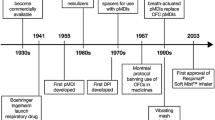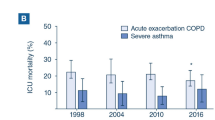Abstract
Objective: British Thoracic Society guidelines advocate the use of oral steroid therapy as a means of controlling symptoms in patients with severe asthma. However, it is well established that there are a number of undesirable adverse effects associated with this form of treatment. The aim of this study was to determine whether the addition of nebulised budesonide reduced oral steroid usage in oral steroid-dependent patients.
Design: A 21- to 35-day run-in period allowed asthma stability to be assessed before patients were randomised in a double-blind manner to receive nebulised budesonide or placebo. At the end of the 15-week treatment period, all patients were given nebulised budesonide and followed for a further 4 weeks. Oral steroid reduction was also studied throughout the treatment period.
Participants: 118 patients (aged 16 to 65 years) with severe oral steroid-dependent asthma (5 mg/day oral prednisolone and ≥800 μg/day inhaled steroid) were enrolled into the study. Of these, 76 were randomised to receive nebulised budesonide or placebo.
Interventions: Eligible patients were randomised to receive either nebulised budesonide 2mg twice daily or nebulised placebo in addition to their existing oral steroid medication.
Results: The addition of nebulised budesonide to existing oral steroid therapy provided a significant reduction in the number of asthma exacerbations experienced over the 15-week treatment period compared with placebo (1.1 vs 0.35; p < 0.05). Moreover, this seemed to be coupled with a marked decrease in the severity of asthma symptoms such as cough (nebulised budesonide group: mean change −0.16; nebulised placebo group: +0.23; p < 0.05) breathlessness (−0.34 vs +0.06; p < 0.05) and sleep disturbance (−0.05 nights per week vs +0.93 nights per week; p < 0.01). Notably, these benefits were achieved without any deterioration in lung function and in conjunction with patients attempting to reduce their dosage of oral steroid. 68% of patients in the nebulised budesonide group were able to achieve a reduction in oral steroid dosage, compared with 53% in the placebo group, although this was not a significant difference.
Conclusions: The addition of nebulised budesonide to regular oral steroid treatment can help to improve symptoms in patients with severe asthma. Moreover, this is achieved without an increase in steroid-related adverse effects. However, the percentage reduction in oral steroid usage between the nebulised budesonide group and the placebo group was not found to be significant (68 versus 53%).





Similar content being viewed by others
References
Barnes PJ, Chung KF. Difficult asthma. BMJ 1989; 299: 695–8
British Thoracic Society, Research Unit of the Royal College of Physicians. Guidelines on the management of asthma. Thorax 1997; 52(1): 1–24
Mygind N. Essential allergy. Oxford: Blackwell Scientific Publications, 1996; 143–244
Chung KE. Management of difficult asthma. Br J Hosp Med 1994; 51(3): 80–1
Otulana BA, Varma N, Bullock A, et al. High dose nebulised steroid in the treatment of chronic steroid-dependent asthma. Resp Med 1992; 86: 105–8
Higginbottam TW, Clark RA, Luksza AR, et al. The role of nebulised budesonide in permitting a reduction in the dose of oral steroid in persistent severe asthma. Eur J Clin Res 1994; 5: 1–10
Llango van P, Pedersen S, Godfrey S, et al. Treatment of severe steroid dependent pre-school asthma with nebulised budesonide suspension. Arch Dis Child 1993; 68: 356–9
Mohan G, MacLusky KA, Godley CC, et al. A comparison of a budesonide based and a beclomethasone/prednisolone based management strategy for the treatment of severe asthma in general practice. Herts, UK: AstraZeneca (Data on file)
O’Connor BJ, Basran GS, O’Connell F, et al. Oral steroid sparing effect of nebulised budesonide in chronic severe asthma. Am J Respir Crit Care Med 1996; 153(4 Pt 2): A431
Skinner RJ, Nunn AJ, Fan Chury K, et al. Randomised, double blind, placebo controlled trial of methotrexate in steroid dependent asthma. Lancet 1990; 336: 137–40
Acknowledgements
The following physicians also contributed to the study: Dr S. Bourke, Dr J.H. Winter, Dr M. Al Shamma, Dr N.F. Thompson, Dr R.D. Monie, Dr A.G. Fennerty, Dr P.A. Corris, Dr D.J. Hendrick, Dr H.W. Clague, Dr D. Spence, Dr N.K. Harrison, Professor J.G. Ayres, Dr P. Dhillon, Dr J. Britton, Dr M.J. Ward, Dr T.K. Rogers, Dr A.A. Jeffrey, Dr T.J. Williams, Dr J.P. Dilworth, Dr A.R. Nath, Dr J.A. Hughes, Dr M.G. Britton, Professor P.W. Jones, Dr R. Djukanovic, Dr J.M. Goldman, Dr D. Dent, and Dr D.M.G. Halpin. Emma Beresford provided statistical analysis. Financial support for this study was provided by Astra Pharmaceuticals Ltd.
Author information
Authors and Affiliations
Consortia
Corresponding author
Rights and permissions
About this article
Cite this article
Connolly, K.C., Peake, M.D., Halpin, D.M.G. et al. Challenging Current Asthma Treatment Guidelines. Dis-Manage-Health-Outcomes 7, 217–225 (2000). https://doi.org/10.2165/00115677-200007040-00005
Published:
Issue Date:
DOI: https://doi.org/10.2165/00115677-200007040-00005




